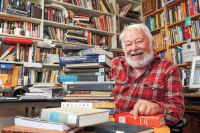Cherokee youth re-enact ancient fishing practice
As 10-year-old Dayini Lossie stood on the shore eyeing the wide shallow waters of the Tuckasegee River last week listening to the marching orders for the exercise about to unfold, one word came to mind: awesome.
Lossie had never heard of a fish weir before, but now she was about to walk in her ancestors’ footsteps, using the same stone wall her people built centuries ago to once again — hopefully — trap some fish.
“The objective is to herd the fish, stomping and screaming and basically scaring them downstream,” explained Mark Cantrell, a biologist with U.S. Fish and Wildlife.
Lossie, along with two dozen other Cherokee students, couldn’t wait. They’d been in and out of the river all day, their shoes, shirts and shorts soaked through many times over as they swam, splashed and explored aquatic biology along the way.
But as they waded into the river this time, stringing themselves out in a long line and facing the ancient weir downstream, they realized they were part of something big.
“We’re learning about our history and how our ancestors used the river,” Lossie said.
Related Items
As the students began moving downstream, flushing the fish toward a trap at the mouth of the weir, it didn’t exactly go off without a hitch. One student would fall, then another, then suddenly the chain would disintegrate leaving big gaps for the fish to sneak through. Some started splashing each other instead of the water in front of them. Others took intermittent breaks to float on their backs.
But eventually, the line closed in on the weir and two modest-sized fish were ushered into the trap.
“We all would have starved if this was dinner tonight,” Cantrell declared.
It became apparent just how much cooperation a fish weir entailed.
“I learned so much myself,” said Roger Clapp, director of the Watershed Association of the Tuckasegee River, which coordinated the event. “Though it is obvious, you could really see how Cherokee fishing at a weir is a community experience, not just one, two or three people.”
The re-enactment was orchestrated by WATR, an environmental group whose central focus is water quality. Funding came from the Cherokee Preservation Foundation, World Wildlife Fund, the Royal Bank of Canada and WATR. To help pull off the re-enactment, biologists with the Cherokee Fish and Wildlife, U.S. Fish and Wildlife, and several volunteers with WATR pitched in.
The field trip brought kids not only in touch with their heritage, but the ecosystem, Clapp said.
Armed with nets and buckets, kids took to the river upturning rocks and sifting through sediment in search of crawdads, bugs and fish lurking below the surface. A science station allowed them to examine their finds under microscopes.
“The creek bottom underneath them is actually teeming with life,” said Clapp. “It is a living ecological unit.”
The students also got to hear a program from Russ Townsend, a historic preservation officer for the Cherokee, who quizzed them on the role rivers played for their ancestors, which included everything from transportation to the gathering of mussel shells that were ground up and mixed with clay for pottery.
“The Cherokee were very smart. They knew how to use the environment. They loved living here because they could get everything they needed and the rivers were a major source of that,” said Townsend









